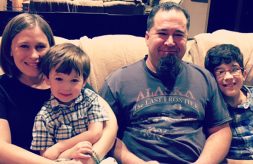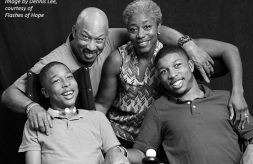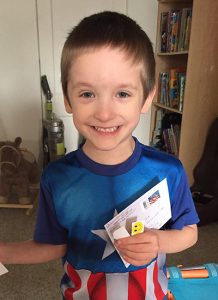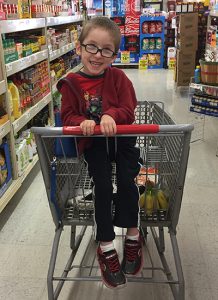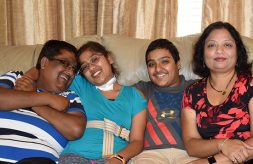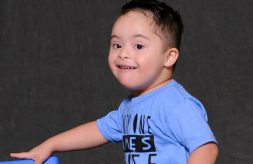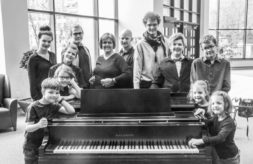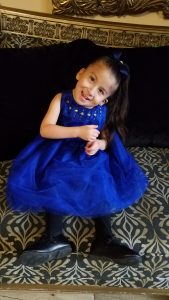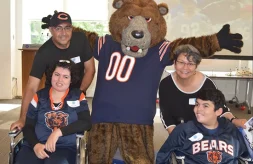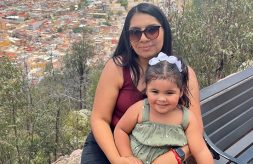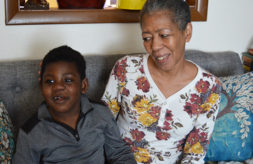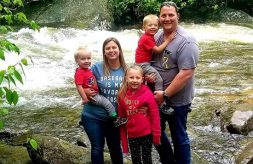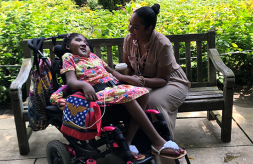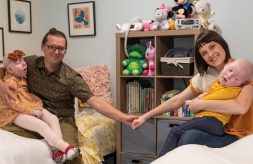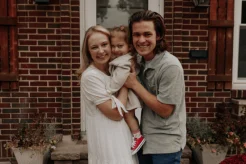The Agarwal Family
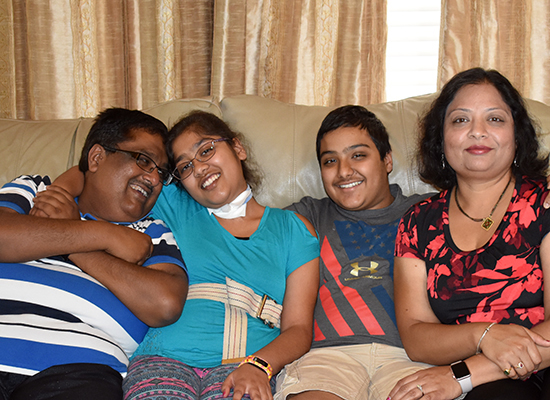
“DSCC gave us the confidence to bring Radhika home... Staying at home is the most important part. It made us a family again.”
— Saurabh Agarwal
“The challenges are still there, but you feel like you are a family.”
In the summer of 2013, Radhika Agarwal was a healthy, active 11-year-old who earned straight A’s in school and loved swimming, soccer, softball and golf.
“She competed with all of the boys in the neighborhood,” her father, Saurabh, recalled.
That August, Radhika started having flu-like symptoms. Within just a few days, she had a massive seizure.
Saurabh and his wife, Mukta, called 911 and their daughter was rushed to the hospital. Radhika’s seizures wouldn’t stop, so she was placed in a medically-induced coma. She was diagnosed with refractory epilepsy with autoimmune limbic encephalitis.
The effects of the disease were devastating. With the help of the University of Illinois at Chicago’s Division of Specialized Care for Children (DSCC), the Agarwals were eventually able to bring their daughter home and find a new normal together as a family of four with her older brother, Ayush.
“You can’t imagine how one night can change your whole life in a few hours,” Mukta said. “It was like she was a baby. We had to teach her how to do everything.”
After that August night, Radhika was hospitalized in intensive care for four months and lost her ability to move and speak. She lost all of her muscle strength and was so weak, she couldn’t hold up a pencil to write her name.
Radhika received a tracheostomy to ensure she gets enough oxygen during her seizures and a gastrostomy tube for medications and nutrition. She also underwent intensive therapy at what is now the Shirley Ryan AbilityLab in Chicago.
Radhika eventually grew stronger and more stable. However, her parents developed a new set of worries.
“We were so scared to bring her back from (the AbilityLab). How were we going to take care of her?” Saurabh said.
Radhika became enrolled in the Home Care Program, which DSCC operates on behalf of the Illinois Department of Healthcare and Family Services. The Home Care Program helps youth who require skilled in-home nursing remain in their family home rather than a hospital or skilled nursing facility.
“We are not medical people,” Saurabh said. “DSCC gave us the confidence to bring Radhika home.”
A DSCC Care Coordinator began working with the Agarwals and walked them through all of the necessary steps and preparations needed for Radhika to transition home safely and smoothly.
Today, Radhika struggles with short-term memory, numerous cognitive issues and vision problems. She also needs assistance to walk. Radhika has a vagus nerve stimulation (VNS) device and is on a ketogenic diet to manage her seizers. She requires round-the-clock care but continues to make strides since returning home, her parents said.
Radhika attends a life skills program at her high school and goes to weekly physical, occupational and speech therapy appointments. She also does adaptive extracurricular activities, like golf and a hip-hop dance class.
The Agarwals say they are grateful for their DSCC Care Coordinator, Amber, who regularly checks in with the family, keeps track of information from Radhika’s doctor’s visits and therapy sessions and helps schedule new appointments.
“You feel a lot more confidence that someone is doing something on your behalf,” Saurabh said.
Most of all, the Agarwals are thankful for living under one roof together as a family.
“Staying at home is the most important part. It made us a family again,” Saurabh said. “The challenges are still there, but you feel like you are a family.”
The Lance Family
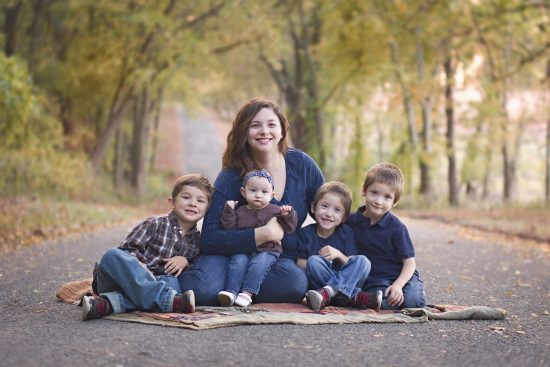
“(DSCC has) been an emotional shoulder to lean on... They’ve helped connect us to various grants for funding and have taken pressure off of myself and my husband when it comes to contacting medical facilities and practitioners regarding services and approvals and payments.”
— Jessica Lance
“An emotional shoulder to lean on…”
Jessica Lance was the first-time mother of a 4-month-old infant when she was pleasantly surprised to discover she was pregnant with her twin sons, Gavin and Gabe.
Thus began a frightening journey to not only deliver the boys safely but help them grow and thrive into their childhood, with the support of the University of Illinois Chicago’s Division of Specialized Care for Children (DSCC).
“The twins were diagnosed with twin-to-twin transfusion syndrome at 16 weeks gestation. The mortality rate is 100 percent if untreated,” Jessica recalled.
Twin-to-twin transfusion syndrome causes too much blood flow from the placenta for one baby and not enough for the other. Jessica said she and her husband, Tim, were given several options, two of which were terminating the pregnancy or letting nature take its course and delivering them stillborn.
“We chose do whatever we could to help them survive. They were tiny people with names and personalities already. Gavin was laid-back and Gabe was feisty,” Jessica said.
They tried two amnioreductions at 16 weeks and 18 weeks to remove excess fluid from Gavin but “both were Band-Aids on a bullet wound,” Jessica said. “The disorder had progressed too far and we were going to lose the boys.”
Jessica and Tim then decided to undergo experimental surgery for the twins called selective fetoscopic laser photocoagulation, which uses a small camera to seal blood vessel connections in the placenta.
“We were given a 90 percent chance of bringing one baby home and a 60 percent chance of bringing them both home. While it was too close to a 50-50 shot, losing them was not an option we were willing to accept,” Jessica said.
“Twenty-four hours after surgery, there were two beautiful little heartbeats.”
Jessica was then on strict bed rest and medication to help reduce the risk of preterm labor. At 30 weeks, however, Jessica had massive internal bleeding caused by a placental abruption.
Gavin and Gabe were delivered via emergency cesarean and were not expected to survive.
“They were not breathing on their own and had aspirated and ingested a large amount of my blood in the womb. Despite all the odds, they came home at just 35 days old from the NICU,” Jessica said.
They were diagnosed with grade IV brain bleeds and a traumatic brain injury called periventricular leukomalacia (PVL). Their neonatologist explained to Jessica and Tim that due to their PVL, Gavin and Gabe would likely have cerebral palsy.
“We were just glad to finally bring our babies home. These were the little boys we had been fighting for
all along,” Jessica said. “Fast forward a year and the signs started coming: gaining skills only to lose them, feeding difficulties, difficulties gaining weight, stiff muscles.”
In addition to their cerebral palsy, a long list of diagnoses followed for the boys, including gastroesophageal reflux disease, global developmental delays, laryngeal clefts, bilateral hernias, chronic ear infections, plagiocephaly and torticollis. Then came the equipment: bilateral ankle and foot orthoses, knee immobilizers, ankle immobilizers, hand braces, resting hand splints, j-splints, wheelchairs, gait trainers and so on.
The twins require a long list of medications and various specialists and therapists to treat their conditions, from occupational and speech therapists to neurologists, urologists and cardiology specialists.
“It’s truly never-ending,” Jessica said.
When the twins were 1 year old, they enrolled in DSCC’s program. Since then, Jessica says DSCC and their Care Coordinator, Robin, have provided invaluable support and assistance.
“They have been an emotional shoulder to lean on when I need to vent frustrations or grieve about a new diagnosis or surgery/procedure” she said.
DSCC has also helped reimburse the family for travel expenses related to Gavin and Gabe’s cerebral palsy appointments and paid for new frames for Gavin’s glasses when insurance denied the expense.
“DSCC has helped with purchasing accessories and equipment that insurance denied that greatly benefit the twins’ mobility and quality of life,” Jessica said. “They’ve helped connect us to various grants for funding and have taken pressure off of myself and my husband when it comes to contacting medical facilities and practitioners regarding services and approvals and payment.”
Robin also helped facilitate the delivery of holiday baskets for the family of seven and gifts through various charity organizations when the family struggled financially.
“DSCC has also connected us with other special needs families going through similar struggles,” Jessica said.
Today, Gavin and Gabe are 4 years old and their parents’ pride and joy.
“The twins have taught us nothing short of unconditional love,” Jessica said. “Even though we face many challenges, with the support of family, friends, and organizations like DSCC (encouraging) us, we are able to help them continue to grow up happy and as healthy as can be.”
Kimmy’s Family
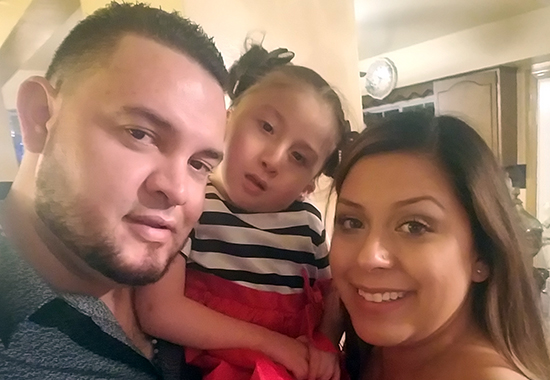
“(Our care coordinator) helped us out so much and would call every day. If we didn’t have DSCC, I don’t know who would’ve helped us.”
— Mayra Pasillas
“We all feel like she has her life back.”
Kimmy spent her first 23 months of life in a hospital.
The toddler was born with congenital scoliosis so severe that it deformed her spine, chest and ribs and prevented her left lung from developing. Kimmy could not breathe on her own and her ribs threatened to crush her lungs.
Kimmy eventually underwent lifesaving surgery to receive a vertical expandable prosthetic titanium rib (VEPTR). The VEPTR device helps straighten Kimmy’s spine and separates her ribs so her lungs can grow. The VEPTR must be expanded regularly until Kimmy stops growing.
After the VEPTR was placed, Kimmy had to undergo a successful expansion surgery before doctors gave the OK for her to go home. It was welcome news but also nerve-wracking to plan for Kimmy’s arrival and care at home, her mother, Mayra, recalled.
“We were just lost. We had no clue. We just wanted to get her home but we didn’t know what it was going to take to get her home safely,” Mayra said.
That’s when their DSCC care coordinator, Margaret, stepped in and began working with Kimmy’s family and doctors to prepare for Kimmy’s homecoming and help it go smoothly. She also worked with charities to help cover the cost of travel expenses for her arrival home and for subsequent surgeries.
“She helped us out so much and would call every day,” Mayra said. “If we didn’t have DSCC, I don’t know who would’ve helped us.”
Later, when Kimmy’s family moved into a renovated older home, Margaret brought in an electrician to replace the power box and install new outlets to support Kimmy’s breathing machines. The house also had issues with ants and spiders, so Margaret set up regular exterminator visits. DSCC ensured all costs were covered under the Medicaid waiver program for children who are medically fragile and technology dependent.
Kimmy is now almost 4 years old and thriving beyond her family’s highest hopes. Mayra says she’s seen a huge difference in her daughter’s progress and happiness since she has been home.
“She’s now standing, walking around and running and she goes to school and is learning all of her little friends’ names,” Mayra said. “We all feel like she has her life back.”
The Lewinski Family
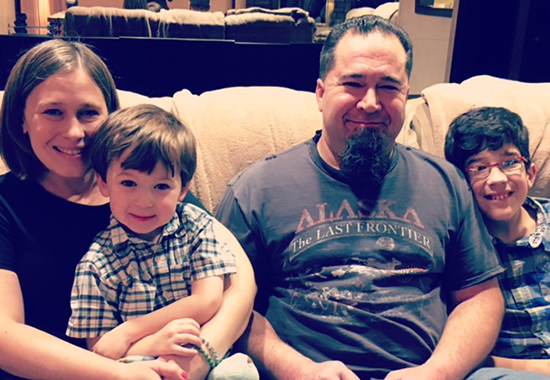
“Our insurance does not cover a lot for Mikey - they don’t cover his catheters, they don’t cover his orthotics, and those are big things that could run thousands of dollars. To have DSCC be able to cover those costs for us has been a huge lifesaver.”
— Michelle Lewinski
“It absolutely makes a difference.”
Mikey is an outgoing 10-year-old who loves to play with his fifth-grade classmates. His mother, Michelle, credits the Division of Specialized Care for Children (DSCC) with helping Mikey receive the orthotics and equipment he needs to keep up with his friends and stay active and happy.
When Michelle was 20 weeks pregnant, Mikey was diagnosed with spina bifida – a birth defect that caused an opening in his backbone and prevented his spinal cord from developing properly – and hydrocephalus, a buildup of cerebrospinal fluid inside the brain. Mikey required surgery immediately after birth to close his backbone. Less than two weeks later, he received a shunt to drain the excess fluid from his brain. His first year was subsequently filled with numerous doctor visits, a shunt revision surgery and the start of physical and occupational therapy to strengthen his muscles.
 Mikey is able to use his legs but requires the use of orthotics and crutches to walk. Michelle said DSCC covered the cost of Mikey’s first set of orthotics at age 1 and has been a huge help to her family ever since.
Mikey is able to use his legs but requires the use of orthotics and crutches to walk. Michelle said DSCC covered the cost of Mikey’s first set of orthotics at age 1 and has been a huge help to her family ever since.
“Our insurance does not cover a lot for Mikey – they don’t cover his catheters, they don’t cover his orthotics, and those are big things that could run thousands of dollars. To have DSCC be able to cover those costs for us has been a huge lifesaver,” Michelle said. “Our Care Coordinator, Sarah, is amazing. She is one of the easiest people I have ever worked with. She follows up with me on how Mikey is doing, how Mikey’s appointments are going and if there is anything we need.”
Sarah was also able to fix communication problems that arose when the Lewinskis recently moved to a new clinic for Mikey’s care.
“She took the reins and was the middleman, making the phone calls and getting stuff done,” Michelle said. “If I have a question about anything, I know that I can call her or just send her a quick email and she will answer my question as soon as she can. It absolutely makes a difference.”
The Jones Family
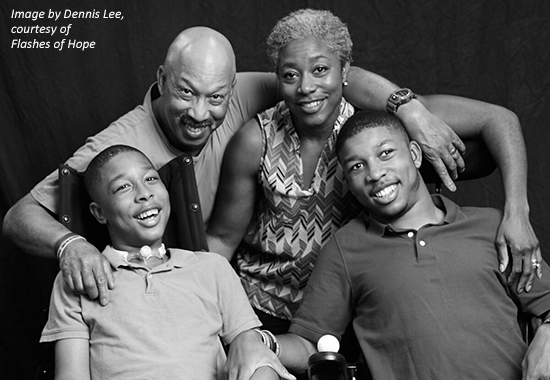
“To have an organization that... (makes) the family’s job, even though it’s a difficult one, run more smoothly, that’s what Specialized Care for Children really does.”
— Gordon Jones
“There’s not a cure, but they still can live a good life.”
Brothers Garrett, 19, and Gavin, 15, share much in common.
The adventurous duo enjoy power soccer and adaptive swimming, sailing, cycling, bowling and rock climbing but also love to relax with an audiobook or listen to music. They naturally attract people with their poise and confidence, and both are “handsome as all get-out,” according to their proud mother, Gina.
“I joke and tell people, ‘It takes a lot to keep them pretty,’” Gina says with a laugh. “They have 14 different doctors. There is a serious team behind them.”
Garrett and Gavin were born with a rare genetic neurodevelopmental disorder called Pelizaeus-Merzbacher Disease that affects their vision and ability to eat, speak, breathe and move.
Garrett was diagnosed when he was 3 years old, just a month before Gina and her husband, Gordon, found out they were expecting Gavin. An amniocentesis before Gavin was born showed that he, too, had the disease but would require greater medical support than his brother.
Both Garrett and Gavin use power wheelchairs, while Gavin has a tracheostomy tube and a gastronomy tube. The first four years of Gavin’s life were very trying and doctors didn’t expect him to live, Gina recalled.
The Joneses first learned of the Division of Specialized Care for Children (DSCC) during Gavin’s hospitalization for tracheostomy surgery, when he was only 1 year old. Gina and Gordon realized they could benefit from the support and care coordination we provide.
The Jones’ care coordinator helped them bring nursing care, therapies and medical specialists together by coordinating communication among the many providers involved in Gavin’s health care. She also helped them work through accessibility issues for their home and transportation needs. Their care coordinator connected them to vendors and guided them through the process of getting a wheelchair accessible van and a lift to get in and out of the house.
“If you don’t have information, you are not able to navigate the travels and travails of being a caregiver for people with a disability,” says Gordon, emphasizing the importance of the ongoing information the family receives from their care coordinator.
“To have an organization that really tries to focus on the family itself, and tries to make the family’s job, even though it’s a difficult one, run more smoothly, that’s what Specialized Care for Children really does,” Gordon says.
Garrett joined his brother, Gavin, in the program in late 2014 after his medical needs grew more complex with age. Both young men now receive skilled in-home nursing care.
“We can’t change the disease. There’s not a cure, but they still can live a good life,” Gina says.
The Joneses incorporate fun and adventure into their daily lives as often as they can. Together, they explore their city and neighborhood; take in cultural events and activities, such as outdoor classical music concerts, operas and plays; camp; play adaptive sports and take cross-country road trips.
“It takes a lot of doing to try to organize what you have to do at home and try to fit outside things in, but it’s necessary because if you don’t continue reaching…you are not going to get anywhere,” Gordon says.
For five years, Gina organized the annual Jones PMD Walk ‘n Roll, a 2.5 mile stroll and roll (wheelchairs, wagons, strollers, and children’s bicycles) to support research, raise awareness and provide support for children who have Pelizaeus-Merzbacher Disease. Gina also became a new part-time Family Liaison for DSCC in early 2017.
Gina and Gordon hope their family’s experiences can help others.
Gordon’s advice to families: “Don’t be afraid to pick up the phone, to read, to look at the computer, because all of these skills you are going to need to navigate the maze effectively.”



